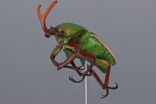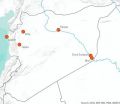This discovery was made by a team of international scientists led by the Singapore Immunology Network (SIgN), a research institute under the Agency for Science, Technology and Research (A*STAR), Singapore.
TB is an air-borne infectious disease caused by a bacterium called Mycobacterium tuberculosis (Mtb), which often infects the lungs. Even though drugs are available to treat the disease, TB continues to be a major threat to public health, killing close to 1.5 million people every year .
Conventional drugs used to treat TB usually adopt a pathogen-targeted strategy which attacks and kills bacteria directly. This approach has caused Mtb strains to acquire drug resistance, making existing treatments become increasingly ineffective and resulting in a pressing need to design new therapeutic strategies for the disease.
MET as an adjunct treatment for TB
The team of scientists led by SIgN began searching for drugs that could control Mtb replication indirectly. They screened FDA-approved drugs and identified MET, an old anti-diabetic drug that could defend Mtb invasion without targeting the bacteria directly. Instead, MET targets the host cells to trigger the production of a chemical which then damages Mtb and stops its replication. Such indirect, host-targeted approach is less likely to engender drug resistance. The team also discovered that MET improves the efficacy of conventional anti-TB drugs when used in combination with them.
The scientists then validated the findings with patient data provided by the Tuberculosis Clinical Unit at the Tan Tock Seng Hospital, and consequently verified that the use of MET is indeed associated with improved TB control and decreased disease severity. This anti-diabetic drug is therefore a promising adjunctive therapy that could enhance the effectiveness of existing TB treatments. As it is a drug that is currently in use, another benefit of using MET as an adjunct treatment for TB is that it is likely to shorten the time required for clinical trials.
"Using MET as an adjunct treatment for TB is very promising since this drug interferes with the biochemical pathway essential for the bacteria's survival and does not promote the development of drug resistance. MET is also a very cheap and safe drug with no adverse effect on non-diabetic patients. This would likely shorten clinical trials and we are confident that a better and affordable TB treatment will be made available soon," said lead scientists Dr Amit Singhal, Project Leader and Prof Gennaro De Libero, Principal Investigator at SIgN.
Prof Wang Yee Tang, Senior Consultant of Tan Tock Seng Hospital's Tuberculosis Control Unit, added, "Today, we are using the same standard TB treatment which was introduced more than 40 years ago. New and better treatment strategies such as this MET adjunctive therapy will definitely be welcomed by TB physicians and patients. It is also important that we continue to protect the few TB drugs we have and prevent drug resistance from emerging."
Professor Laurent Renia, Executive Director of SIgN, said, "The use of old drugs for new therapies is exciting. This study is an excellent example of innovation, made possible because of the closely knitted scientific and clinical communities in Singapore. By collaborating with our clinical partners, we are able to translate our research findings from the bench-to-bedside and ultimately impact the lives of people."
INFORMATION:
Notes to Editor:
The research findings described in this media release can be found in Science Translational Medicine, under the title, "Metformin as adjunct antituberculosis therapy" by Amit Singhal1*, Liu Jie1†, Pavanish Kumar1†, Gan Suay Hong2, Melvin Khee-Shing Leow3,4, Bhairav Paleja1, Liana Tsenova5,6, Natalia Kurepina5, Jinmiao Chen1, Francesca Zolezzi1, Barry Kreiswirth5, Michael Poidinger1,7, Cynthia Chee2, Gilla Kaplan5,8, Yee Tang Wang2, Gennaro De Libero1,9*
1Singapore Immunology Network, Agency for Science, Technology and Research (A*STAR), Singapore 138648, Singapore;
2Tuberculosis Control Unit, Tan Tock Seng Hospital, Singapore 308089, Singapore;
3Department of Endocrinology, Tan Tock Seng Hospital, Singapore 308433, Singapore;
4Singapore Institute for Clinical Sciences, A*STAR, Singapore 117609, Singapore;
5Public Health Research Institute at New Jersey Medical School, Rutgers University, Newark, NJ 07103, USA;
6New York City College of Technology, Brooklyn, NY 11201, USA;
7Department of Biological Sciences, National University of Singapore, Singapore 117543, Singapore;
8Bill & Melinda Gates Foundation, Seattle, WA 98109, USA;
9University Hospital Basel, University of Basel, Basel 4031, Switzerland;
†These authors contributed equally to this work.
Full text of the Science Translational Medicine paper can be accessed online from: http://stm.sciencemag.org/content/6/263/263ra159
For media queries and clarifications, please contact:
Tan Yun Yun
Senior Officer, Corporate Communications
Agency for Science, Technology and Research
Tel: +65 6826 6273
Email: tan_yun_yun@a-star.edu.sg
About A*STAR's Singapore Immunology Network (SIgN)
The Singapore Immunology Network (SIgN), officially inaugurated on 15 January 2008, is a research consortium under the Agency for Science, Technology and Research (A*STAR)'s Biomedical Research Council. The mandate of SIgN is to advance human immunology research and participate in international efforts to combat major health problems. Since its launch, SIgN has grown rapidly and currently includes 250 scientists from 26 different countries around the world working under 28 renowned principal investigators. At SIgN, researchers investigate immunity during infection and various inflammatory conditions including cancer and are supported by cutting edge technological research platforms and core services.
Through this, SIgN aims to build a strong platform in basic human immunology research for better translation of research findings into clinical applications. SIgN also sets out to establish productive links with local and international institutions, and encourage the exchange of ideas and expertise between academic, industrial and clinical partners and thus contribute to a vibrant research environment in Singapore.
For more information about SIgN, please visit http://www.sign.a-star.edu.sg.
About the Agency for Science, Technology and Research (A*STAR)
The Agency for Science, Technology and Research (A*STAR) is Singapore's lead public sector agency that fosters world-class scientific research and talent to drive economic growth and transform Singapore into a vibrant knowledge-based and innovation driven economy.
In line with its mission-oriented mandate, A*STAR spearheads research and development in fields that are essential to growing Singapore's manufacturing sector and catalysing new growth industries. A*STAR supports these economic clusters by providing intellectual, human and industrial capital to its partners in industry.
A*STAR oversees 18 biomedical sciences and physical sciences and engineering research entities, located in Biopolis and Fusionopolis, as well as their vicinity. These two R&D hubs house a bustling and diverse community of local and international research scientists and engineers from A*STAR's research entities as well as a growing number of corporate laboratories.
For more information on A*STAR, please visit http://www.a-star.edu.sg.


